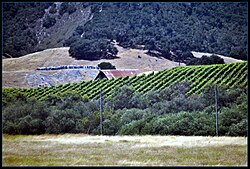| Wine region | |
 SLO Coast vineyard | |
| Type | American Viticultural Area |
|---|---|
| Year established | 2022[1] |
| Years of wine industry | 220[2] |
| Country | United States |
| Part of | California, Central Coast AVA, San Luis Obispo county |
| Other regions in California, Central Coast AVA, San Luis Obispo county | Paso Robles AVA |
| Sub-regions | Edna Valley AVA, Arroyo Grande Valley AVA |
| Climate region | Region I, II[1] |
| Precipitation (annual average) | 16.8 inches (426.7 mm)[3] |
| Soil conditions | sandy loam, Pismo, Briones, Tierrs, Gazos, Nacimiento, Linne, Balcom, and Sorrento soil series[1] |
| Total area | 408,585 acres (638 sq mi)[1] |
| Size of planted vineyards | 3,942 acres (1,595 ha)[1] |
| No. of vineyards | 78[1] |
| Grapes produced | Cabernet Sauvignon, Chardonnay, Gewürztraminer, Grenache, Gruner Veltliner, Pinot Noir, Merlot, Mourvedre, Sauvignon Blanc, Syrah, Zinfandel[4] |
| No. of wineries | 50[1] |
San Luis Obispo Coast and SLO Coast identify the sixteenth American Viticultural Area (AVA) within San Luis Obispo County, California. It was established by the Alcohol and Tobacco Tax and Trade Bureau (TTB), Treasury on April 8, 2022, becoming the state's 143rd official AVA.[5] The area encompasses over 480,585 acres (750.914 sq mi) nestled between the Santa Lucia mountains and the Pacific coastline stretching about 70 miles (110 km) from Ragged Point southbound on the Pacific Coast Highway (PCH) and Highway 101 to the outskirts of Santa Maria at the intersection of State Highway 166 and Highway 101. It includes the coastal communities of San Simeon, Cambria, Cayucos, Morro Bay, Avila Beach, Pismo Beach, Arroyo Grande and Nipomo while encompassing the county seat of San Luis Obispo. The TTB approved the petition's two names, "San Luis Obispo Coast" and "SLO Coast", to identify the viticultural area's description and wine labeling. The term "SLO" is a historical and commonly used reference for the county and city initials as well as a description of the region's relaxed culture. The new AVA overlaps the previously established Edna Valley and Arroyo Grande Valley viticultural areas. There are over 50 wineries and an estimated 78 commercial vineyards cultivating approximately 3,942 acres (1,595 ha) with a majority of the vineyards located within 6 miles (9.7 km) of the Pacific Ocean defining an area whose grapes and wines represent it. Cool weather varietals like Pinot Noir and Chardonnay are commonly grown while lesser varietals Sauvignon Blanc, Gewürztraminer and Gruner Veltliner also thrive.[1][5]
- ^ a b c d e f g h "Establishment of the San Luis Obispo Coast (SLO Coast) Viticultural Area" (27 CFR 9, 87 FR 13160 [Docket No. TTB-2020-0009 T.D. TTB-177 Ref: Notice No. 194] Final Rule). Federal Register. 87 (46). Alcohol and Tobacco Tax and Trade Bureau {TTB), Treasury: 13160–13165. March 9, 2022.
 This article incorporates text from this source, which is in the public domain.
This article incorporates text from this source, which is in the public domain.
- ^ Agran, Libbie (April 19, 2021). "Central Coast Timeline: Early Wine History" (Wine - 16th to 18th Century History). The Wine History Project of San Luis Obispo County.
- ^ "Climate in San Luis Obispo County, California". USA Facts. Retrieved May 5, 2022.
- ^ "San Luis Obispo County Wine". Wine Searcher. Retrieved March 5, 2021.
- ^ a b Sonderling, Don (February 5, 2022). "New SLO Coast AVA" (Standing on its Own). Wine Country This Week. Archived from the original on May 18, 2022.